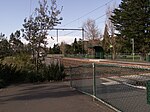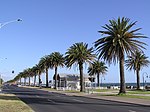North Port Oval, also known as the Port Melbourne Cricket Ground or by the sponsored name ETU Stadium, is an Australian rules football and cricket stadium located in Port Melbourne, Australia. The capacity of the venue is 12,000 people. It is home to both the Port Melbourne Cricket Club and the Port Melbourne Football Club.
The ground is one of the Victorian Football League primary venues, and each year, it will usually host two finals in the first week, then both semi-finals and both preliminary finals. This has been the case almost continuously since 1996. The ground has hosted a total of seven VFA/VFL top division Grand Finals: in 1931, 1963, 1964, 1965, 1997, 1998 and 1999.
The crowd record estimated to be 32,000 witnessed the 1953 Sunday Amateur League Grand Final between Montague and Carlton; the ground's highest VFA crowd of 26,000 was set at the 1964 Division 1 Grand Final between Port Melbourne and Williamstown.
On 12 November 1927 the foundation stone for the main grandstand was laid by the Mayor of the City of Port Melbourne, Cr. A.Tucker JP. In the 1970s the main grandstand was named the Norman L Goss Stand in honour of long-time Port Melbourne Football Club administrator Norm Goss Sr. On 30 May 2015 the redevelopment of the oval and facilities was officially opened by Mayor Cr. A.Stevens and Hon. Martin Foley MP (Member for Albert Park), with funding from City of Port Phillip, Port Melbourne Football Club, the AFL, AFL Victoria, and Victorian Government. The ground is now also home to the Sandridge Events Centre, located at the Woodriff St end of the ground.
In 2014, the ends of the ground were renamed to honour of the Port Melbourne Football Club's two champion goalkickers, Fred Cook (1210 goals) and Bob Bonnett (933 goals). The Woodruff St end is known as the Fred Cook End, and the Williamstown Rd end is known as the Bob Bonnett end.The ground has been known by several sponsored names during the 21st century. It is presently known as ETU Stadium under a sponsorship deal with the Electrical Trades Union of Australia. Under its longest-lasting name, it was known as TEAC Oval from 2000 until 2011. It has previously had short term naming rights deals lasting only the end of the home and away season and the finals as Fortburn Stadium in 2017 and Stannards Stadium in 2018; and for the full season in 2019 as Adcon Stadium.









